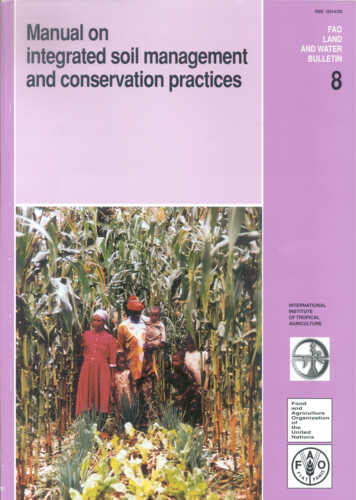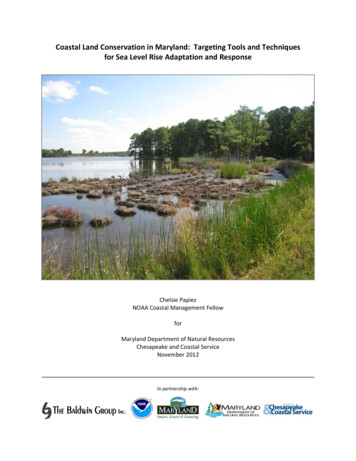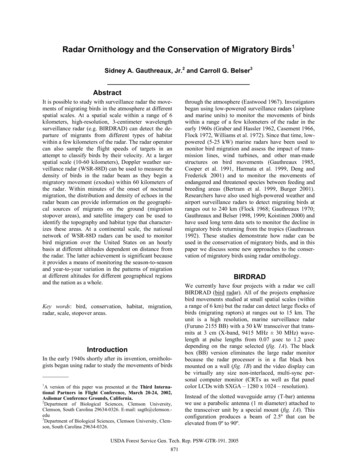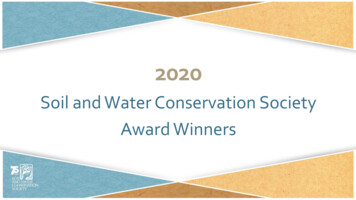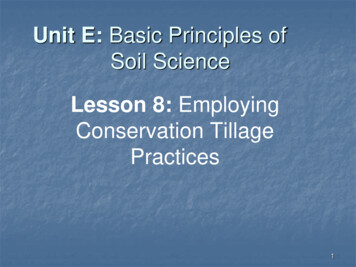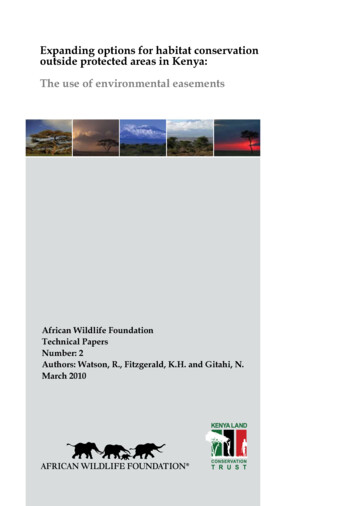
Transcription
Expanding options for habitat conservationoutside protected areas in Kenya:The use of environmental easementsAfrican Wildlife FoundationTechnical PapersNumber: 2Authors: Watson, R., Fitzgerald, K.H. and Gitahi, N.March 2010
2
Table of ContentsList of nding Options for Conserving Wildlife7Habitat outside Protected Areas in Kenyathrough Environmental EasementsUsing Environmental Easements to10Preserve Wildlife Habitat in KenyaValuing Environmental Easements 1924Conclusion30References31Annex 132Annex 2403
List of AcronymsAWFAfrican Wildlife FoundationEMCAEnvironmental Management and Coordination ActFMVFair Market ValueIRSInternal Revenue ServiceIUCNInternational Union for Conservation of NatureKLCTKenya Land Conservation TrustKPLCKenya Power and Lighting CompanyKWSKenya Wildlife ServiceLCALand Control ActNEMANational Environment Management AuthorityNGONon Governmental OrganizationRLARegistered Land ActUSAUnited States of AmericaUNEP/WCMCUnited Nations Environment Programme/World Conservation Monitoring CentreAcknowledgementsThis publication was funded by the Royal Netherlands Embassy through the African Wildlife Foundation’sHeartlands Program. A large thank you to the AWF initiated Environmental Easement Working Group formaking this paper happen – Ms. Nyokabi Gitahi, Ms. Kathleen Fitzgerald, Dr. Rupert Watson, Prof. PatriciaKameri-Mbote, Dr. Helen Gichohi and Dr. Julian Fennessy. Additionally, we would like to thank all those whoparticipated and provided invaluable input into the AWF Environmental Easement Workshop in Nairobi in 2008.Finally, we would like to thank Ms. Bernadette Gitari of Knight Frank, Ian Illingworth of Ryden International, Dr.Migai Aketch of the University of Nairobi, and Mr. Sam Lawson of The Nature Conservancy, who all reviewedthe paper.4
SummaryKenya is renowned for its national parks and the abundance and diversity of wildlife; however, Kenya’s protectedareas are too small, fragmented and not viable to maintain the current wildlife populations which rely on largerecosystems than protected within the national parks. The threats against wildlife in Kenya continue to escalatedue to an increase in habitat fragmentation, change in land use and human population pressure in areas outsideparks. To secure Kenya’s ecological integrity and maintain viable populations of wildlife, land outside protectedareas must be preserved through innovative conservation measures such as environmental easements. Kenyacurrently lacks the enabling legal framework to use environmental easements as a voluntary conservationmechanism. However, legislative changes regarding the current environmental easement framework can beused to provide for their (voluntary) establishment.This paper examines wildlife conservation in Kenya on land outside protected areas. It presents a contextwithin which environmental easements as a mechanism to conserve wildlife habitat outside protected areascan be considered based on property rights over land and the management of wildlife resources and theirimplication for habitat conservation. This paper also describes easements, the legal environment needed inKenya for adopting environmental easements and makes specific legislative recommendations. A sampleenvironmental easement, adapted for Kenyan circumstances from an American model, is presented. Alsooutlined are methods of valuing environmental easements, a critical link in establishing a solid framework andprocess for having an environmental easement granted. Billy Dodson5
1.0. IntroductionKenya is home to a large abundance and diversity of wild species of birds, mammals and plants across amyriad of habitats. Kenya’s wildlife is the basis of the country’s tourism industry; an industry second only toagriculture as a national source of revenue. One of the major concerns for wildlife conservation, however, isthe loss of wildlife habitat through change in land use and land cover outside protected areas.The African Wildlife Foundation (AWF) has supported conservation of wildlife resources through variousstrategies including land and habitat conservation; species conservation and applied research; conservationenterprise; capacity building and leadership development; and, policy.AWF has backed several initiatives including research on legal and economic mechanisms for conservingwildlife habitat outside protected areas. One of the outcomes of this process was the establishment of theKenya Land Conservation Trust (KLCT) as a national land conservation organisation. The Trust brings togetherkey partners in wildlife conservation and landowners to support land conservation across the country. KLCTaims to apply legal and economic tools including leases, easements, management support and land purchaseto set aside and manage critical wildlife habitat outside protected areas in Kenya.Recognizing the need for increased options for landowners to provide long-term conservation of wildlife habitatthrough legally, socially and economically sound and acceptable methods, AWF constituted a multi-disciplinaryteam experienced in economics, ecology, law, land management and habitat conservation to research andprovide practical options for sustainable conservation of wildlife habitat outside protected areas using propertybased rights mechanisms. The Environmental Easement Working Group examined environmental easementpolicies established under the Kenyan Environmental Management and Coordination Act (EMCA), 1999, as amechanism for regulating land use and providing benefit to landowners whilst enhancing conservation and theenvironment, including the preservation of wildlife and their habitat.This publication targets law and policy makers, non governmental organizations (NGOs) involved in wildlifeand habitat conservation, and landowners in wildlife areas. It is the first output of an initiative seeking anenabling legal, institutional, policy and economic framework that encourages, promotes and supports theuse of (voluntary) environmental easements for conserving wildlife habitat outside protected areas in Kenya;the development of the law and practice on easements as a habitat conservation mechanism; increasedhabitat conservation options for conservation organizations and landowners, and increased awareness onenvironmental easements as a habitat conservation option. Alejandro Tawil1Tourism accounts for approximately 12% of Kenya’s GDP, providing about 400,000 jobs in the formal sector (and a further 600,000 in the informal sector). 80% of international visitors to the country areattracted by the opportunity to view wildlife in its natural habitat, particularly large mammals.6
2.0. Expanding Options for Conserving Wildlife Habitat outsideProtected Areas in Kenya through Environmental Easements2.1. Habitat lossKenya has established five national sanctuaries, 22 terrestrial national parks and 28 terrestrial national reservesthat in total amounts to approximately 8% of the country’s land mass as wildlife habitat. Various land useactivities including agriculture, settlement and livestock keeping are prohibited in these areas and access tothe protected areas is regulated by law. Kenya’s protected areas that are famous for providing great viewing forwildlife include the Maasai Mara National Reserve, famous for the annual migration of wildebeests and zebrasin the Mara-Serengeti ecosystem; Amboseli National Park in southeast Kenya; and the Tsavo East and TsavoWest National Parks.Protected areas alone cannot sustain wildlife in Kenya. Many were set aside due to the large aggregations andmigrations of wildlife that occurred in these areas either during wet or dry seasons, and which captured theattention of the colonial government. At the time there was little understanding of how ecosystems function.Consequently, the areas that were set aside were and continue to be inadequate to support wildlife withineach of the ecosystems. As a result wildlife depends on land adjacent to these protected areas for continuedviability with much of Kenya’s wildlife known to spend at least a part of their seasonal or life cycle in open landadjacent to protected areas. They use these adjacent lands as critical dispersal areas, calving grounds and/orfor seasonal movement between protected areas.Loss of wildlife habitat is one of the main cause of declining species number and abundance in Kenya. Fifty one(51) mammal species in Kenya, out of a total of 376, are reported to be threatened with extinction. This lossdirectly undermines conservation efforts and the tourism industry, a significant contributor to poverty reductionin Kenya. It further denies some local communities living in wildlife areas the opportunity to earn a living out ofthese resources through tourism based enterprises.Land outside protected areas is vulnerable and has been subject to unregulated change of use from openwildlife habitat to cultivated agriculture, settlement and urban development. Some examples include: the establishment of wheat farms north around the Maasai Mara National Reserve, impeding thehistorical annual wildebeest migration dispersal from the Maasai Mara National Reserve intocommunity lands in the north before returning south to the Serengeti National Park in Tanzania; the development of industrial, as well as human, settlements in the Athi-Kapiti ecosystem (Kitengelaarea) south of Nairobi National Park, is blocking the seasonal migration of wildebeests andzebras in and out of the park and to the southern calving and seasonal grazing areas of the ecosystem.The once large migration is all but gone; and the declining numbers of the endangered Grevy’s zebra in northern Kenya, is greatly affected bycompetition with livestock for water and grazing land.Loss of wildlife habitat outside protected areas in Kenya should be halted to ensure: the viability and largeabundance and diversity of species; maintaining existing and provide additional new areas for the growing7
tourism industry to operate; and, sufficient space to provide resilience to critical ecosystems as well as speciesas climate changes and climate variability poses new threats.2.2. Environmental easementsConservation restrictions through environmental easements or conservation leases are valuable tools foraddressing loss of wildlife and their habitat outside protected areas. These rights limit the use of land toactivities that do not negatively impact wildlife habitat on the land. The limitations to land use include prohibitingthe following: erection of fences or barriers that impede wildlife movement; conversion of land for developmentor cultivation; and, keeping livestock numbers above a level compatible with wildlife conservation based onavailable pasture and water. The limitation of use is granted to an institution or other party through a deedand the grantee has the legal right to enforce it against the land owner. In return, the land owner is entitled tocompensation for the user rights foregone, at an appropriate economic value. This approach is used extensively,for example, in the United States of America (USA), through conservation easements that are backed by taxrebates for landowners who voluntarily limit the use of their land by donating a conservation (or environmental)easement to a legally designated conservation organization.Environmental easements in Kenya could provide incentives for landowners in wildlife-rich areas to conservetheir land for wildlife habitat. Currently, landowners largely bear the costs of hosting wildlife on their property. Theloss is manifested through competition between livestock and wildlife for limited pasture and water, transmissionof disease to livestock and costs of veterinary services, loss of crops and property, and at worst, loss of lifeas seen in many areas with high rates of human-wildlife conflict. In a number of cases, the government hasresorted to erecting electric fences to keep wildlife away from human habitation to minimize conflict. To manylandowners, wildlife is a pest. While the government, through national parks and reserves, may benefit frommaintaining the wildlife resource through activities such as tourism.There are limited incentives for landowners to conserve wildlife habitat on their land, instead, there is opportunityfor pay-off if land is converted to other uses, such as wheat cultivation. This has been the case in Narok District,north of the Maasai Mara National Reserve. Agriculture, with large government incentives, e.g. on costs offertilizer and access to credit and availability of market to sell their products, offers higher returns compared towildlife conservation, hence the proliferation of wheat and flower farms in the area. There are no correspondingincentives for wildlife conservation and this presents the landowner with little choice but agriculture as aviable land use option. Even in drier areas where cultivation is not a viable land use, landowners still attemptsubsistence farming despite repeated crop failure. Furthermore, in communities that enjoy returns from wildlife,a few members still opt for agriculture as tourism benefits does not always accrue to the community equally.Where livestock is the mainstay, their density is often high and often limits wildlife numbers due to competitionfor limited pasture and water resources. Environmental easements could provide an opportunity for landownersto set aside part of their land for wildlife conservation and receive a benefit in exchange for the user rightsforegone.While environmental easements as a property rights based mechanism provides an opportunity to conserveimportant wildlife areas outside protected areas in Kenya; for easements to truly succeed there must be8
an enabling legal, institutional, policy and economic framework that encourages, promotes and supportseasements as a voluntary mechanism for conserving wildlife habitat. This would in turn result in the law andpractical application of easements as a habitat conservation mechanism or tool in Kenya which would increasehabitat conservation options for AWF, KLCT, landowners and other conservation organizations.Some of the ‘gaps’ on environmental easements as a habitat conservation mechanism in Kenya include: law enabling the creation of voluntary easements between willing parties; valuation mechanisms or principles to determine the appropriate value of an environmentaleasement; institutional framework to implement environmental easement mechanisms; and provision of an appropriate precedent in law, in form and practice, in the use of environmentaleasements that would be replicated and adapted for habitat conservation in Kenya.Notably, it has been approximately a decade since the law on environmental mechanism was enacted inthe Environmental Management and Coordination Act (EMCA) of 1999, but to this date the environmentaleasement component – Part IX of the Act, Sections 112 to 116, has not been implemented and as such has notbenefited wildlife conservation in Kenya.2.3. What is an easement?Historically, under the English legal system, an easement was a right attached to one piece of land either touse other land in different ownership in a particular manner or to restrict the use of that other land by its owner.More recently, conservationists in USA and elsewhere are using easements to restrict the right to developland or to limit its use in other ways inconsistent with environmental preservation. Rights, such as to fence orcultivate, are surrendered voluntarily or sold by the landowner without changing the actual ownership of theland. This has given rise to ‘conservation easements’ as is the case in the USA or to ‘environmental easements’in Kenya – these are statutory easements that modify the requirements, characteristics and the use of theEnglish common law easement to enable their use for purposes of conservation.2.4. Kenya’s environmental easementIn 1999, Kenya enacted EMCA as a framework law for environmental management and conservation, and alsoestablished the National Environment Management Authority (NEMA) as the key institution to implement the Act.Sections 112-116 of EMCA provide for the creation of environmental easements to facilitate the conservationand enhancement of the environment, by imposing one or more obligations on land use. While this statuteprovides an opportunity to place easements on land to secure natural resources, it is inadequate in promoting aviable and voluntary tool that landowners may use to preserve their land. To date, no environmental easementshave been tested through the court as required by EMCA.9
3.0. Using Easements to Preserve Wildlife Habitat in Kenya3.1. The general law on easements in England and KenyaThe English Common Law consists of ancient customs and usages, recognized over almost the past 1,000 yearsand given the force of law, usually through reported decisions of the courts. It has come to mean the entire bodyof English law other than Statute law is what exists in Kenya today, and as such the principal easement in usein Kenya is that from English Common Law. The easement was adopted into Kenyan law by the Kenya Order inCouncil of 1921, which approved the general application to Kenya of English Common Law as it was on 12 August1897. The Order in Council was subsequently confirmed in independent Kenya by the Judicature Act of 1967.Easements over land in England evolved to legalize the possibility of the owner of one piece of land enjoyingcertain rights over adjacent land owned by someone else. Thus, a right over one piece of land – like a right ofway – would exist to benefit an adjoining piece of land. In legal terminology, the piece of land burdened withthe easement constituted the ‘servient tenement’ and that enjoying the benefit of the easement was knownas the ‘dominant tenement’. Such easements are passed on during the transfer of either the burdened or thebenefiting land and, typically, are registered against title.The Registered Land Act ((RLA) and Cap 300 of the Laws of Kenya) gives statutory recognition to the easementthat in S3 it defines as: a right attached to a parcel of land which allows the proprietor of the parcel of land either to use the landof another in a particular manner or to restrict its use to a particular extent, but does not include a profit.(see later for reference to ‘profit’)S94 RLA allows that: ‘The proprietor of land or a lease may, by an instrument in the prescribed form, grantan easement over his land or the land comprised in his lease, to the proprietor or lessee of other land for thebenefit of that other land.’The RLA then goes on to specify how easements are created, documented and registered.From both these statutory excerpts, it is clear that the historic requirement for an easement over land to benefitanother piece of land is perpetuated (although of course the RLA only applies to land adjudicated under that Actand not to land registered under the Government Lands Act, Registration of Titles Act or Trust Land Act, noneof which gives statutory recognition to easements).Easements can be created voluntarily by owners of adjacent lands or acquired by prescription. S32 of theLimitation of Actions Act (Cap 22) allows that where a building has enjoyed ‘access and use of light or air ’, orthat the use of water or any other easement ‘has been enjoyed peaceably and openly as of right, and withoutinterruption, for twenty years, the right is absolute and indefensible.’Easements are better understood when considered as positive or negative. Positive easements include rightsof way to attach telephone wires or name boards to adjoining buildings or to place advertising hoardingson neighboring land. Among negative easements are rights to light (so effectively creating a restriction on10
building), water from a watercourse or to the support of a building on the dominant tenement from an adjacentbuilding on a servient tenement.3.2. In grossDespite the fundamental requirement that an easement over land can only operate to benefit another piece ofland, there has long existed the concept of a grant of rights over land that need not benefit any other land. Thiswas known under Common Law as a ‘profit’ and covered such rights as extracting soil or rock, collecting woodor fishing. Any such right could be granted to a person, irrespective of whether he owned land. In other wordsthe profit could exist ‘in gross’.S3 of the RLA also recognizes profits, defining them as: the right to go on the land of another and take a particular substance from that land, whether the soil orproducts of the soil It was only a small step from the notion of a profit, to what gradually became known as an ‘easement in gross’.This extends the idea of profit – with no requirement to benefit another piece of land – to easements. In manyjurisdictions based on the English legal system, these can now be granted to individuals or organizations withno connection to any adjacent property.In Kenya, such rights may be conferred by statute in favor of service distribution companies, for example,the Electric Power Act (Cap 314) allowing the Kenya Power and Lighting Company Limited (KPLC) the rightto traverse land with power lines without the consent of the landowner, or the Wayleaves Act (Cap 292)granting the government power to run ‘ any sewer, drain or pipeline into, through, over or under any landswhatsoever ’. These rights are absolute and can be enforced whether or not KPLC or the government ownsany other land.Providing water often depends on the right of an extractor to lay pipes across the land of several differentowners and S2 of the Water Act of 2002 defines an easement as: the right to occupy so much of the lands of another as may be necessary for or incidental to theconstruction or maintenance of works authorised, or the exercise of rights conferred by a permit The only form of easement envisaged by the Water Act is one ‘in gross’ and it devotes all the eighteen sectionsof the Third Schedule to establishing a detailed system of easements to allow permit holders to construct andmaintain water reticulation systems over land owned by other people. In addition to these formal easements‘in gross’, there is nothing to stop any landowner from entering into a contract to grant rights over land toanother party – whether a landowner or not. A landowner, therefore, could grant a safari operator the right totake visitors across his land on foot, by horse or vehicle or to collect dead wood for his camp. Such grants ofrights do not operate as easements because they are not granted under any statute allowing the creation of aneasement ‘in gross’; rather they are private contracts affecting an area of land and they operate as profit. Theycan only be enforced by one party against the other as contracts, and being personal to the parties who enterinto the contract, do not pass with the land on its transfer.11
To stress the essence of an ‘easement in gross’ here is the definition from Black’s Law Dictionary, emphasizingthat the easement is:.not appurtenant to any estate in land or does not belong to any person by virtue of ownership of estate inother land but is a mere personal interest in or right to use land of another; it is purely personal and usuallyends with the death of the grantee.Where interests or rights are granted to an organization, then the grant will last as long as permitted e.g.perpetuity or time bound, and may also contain a power of assignment to another institution.3.3. Easements as tools of conservationOnce statute recognizes the right of easements to exist ‘in gross’, there is further opportunity for taking flexibleand creative advantage of these instruments.The USA makes considerable use of easements as conservation tools, having recognized their ability to exist‘in gross’ in many states of the union. It is, therefore, appropriate to look at how easements can work to benefitconservation, if the enabling legal environment is in place, before returning to the changes to the Kenyan lawbrought about by EMCA.In the USA a conservation easement may be defined as: a legal agreement which a property owner makes to restrict the type and amount of development thatmay take place on his or her property.From a more fiscal angle, it can also be defined as: a legal agreement between a landowner and qualified organisation (as defined by the IRS) thatpermanently limits uses of the land in order to protect its conservation value To understand the concept of an environmental easement, it is useful to think of land ownership as the ownershipof a bundle of different rights. Some of these include: the right to build, fence, subdivide land, cut down trees orplant different species of vegetation (all always subject to the relevant planning and other local regulations).A landowner may then sell or give away the whole bundle of rights – as an outright sale or gift of land – orotherwise convey certain rights, as would happen on the grant of an environmental easement. The conveyanceof rights takes effect when the landowner prohibits specific uses on the land. The organization that acceptsthese rights may choose not to use them and must enforce the prohibitions. Under enabling legislation theserights may be extinguished or in some cases ‘traded’.An easement may deprive the landowner of rights, such as building structures, hunting game birds andmammals, harvesting timber, constructing fences or extracting soil and minerals. By forfeiting these rights,the owner is foregoing the possibility of fully using or developing the property. The rights that need to be givenup to protect the land depend on the purposes of the conservation easement, the conservation goals of theparties and the extent to which the parties intend to use the land or the types of development to be restricted.In some cases, for example, cattle ranching may be acceptable and not interfere with the conservation of an12
area, whereas in others it may not be so.Conservation easements vary significantly. Those designed to protect the land as a nature reserve prohibitdevelopment, resource extraction and vehicular access. At the other end of the spectrum an easement may bedesigned to protect scenic views and so it can be less restrictive.The rights foregone by the owner are set out in an easement as restrictions on the use of the property. Thepower to enforce these restrictions is granted to the easement holder that could be a non-governmentalorganization (NGO) or other conservation-centered entity legally entitled to accept conservation easements.Enforcing easements involves monitoring the state of the property through regular visits, often in the companyof the landowner, who, if living on the property at the time the easement was granted, may continue to do sopending the easement language. Most easement holders conduct site visits at least annually and record detailsthat the landowner signs as a true reflection of the state of the land. The purpose of such visits is to ensure thatthe landowner, or third parties, has not breached any of the provisions of the easement. If the provisions havebeen breached then the landowner is requested to remedy the infringement. If the landowner, for example, hasconstructed buildings that breach the conditions of the easement, they would be requested to take them downand potentially restore the area appropriately.Before a conservation easement is conveyed, the prospective holder will normally prepare what is known in theUSA as a Baseline Documentation Report, describing, inter alia, the land, its current use, existing buildings andinfrastructure. The landowner and easement holder then sign the report that, from then on, acts as a referencefor the state of the land at the start of the easement.An easement usually lasts in perpetuity. In Kenya, under EMCA 112(3) ‘An environmental easement maybe imposed on and shall thereafter attach to the burdened land in perpetuity or for a term of years or for anequivalent interest under customary law as the court may determine.’ However, much of Kenya’s rural land ison leasehold and an easement would, therefore, be restricted by the period of the leasehold.In the USA and elsewhere, granting an easement may reduce the value of the land for estate or property taxpurposes, the gift also qualifying for deduction from income tax. Under the present tax regime in Kenya, thereare no such advantages, not least because there is neither estate nor capital gains tax.3.4. The essence of an environmental easementFundamental to the creation of an easement is a basic understanding of its purpose: What is the grant of easement intended to protect? Is it designed to preserve a wilderness area for local communities to enjoy, or does it have more specificobjects, such as securing the use by migratory birds of a wetland, conserving ideal rhino habitat or isit one of the last refuges of a rare orchid?These conservation values need to be appraised and then detailed in the recitals of the easement document.Such values will act as the basic reference point against which the successful working of the easement –whether it is actually achieving its aim – can be measured.13
The opening section of an environmental easement includes a clear statement of purpose that will also helpto interpret the success, or otherwise, of the easement in the future. The purpose statement of an easementdesigned to maintain wilderness in as pristine a condition as possible might read:To maintain, preserve and restore the wilderness character of the Protected Property in a natural condition,with minimum interference by humans in order to conserve plant and wildlife habitats and biologicaldiversity, native flora and fauna, and the environments and ecological processes that support them, asthose values exist on the Protected Property on the date of this easement as des
in Kenya. It further denies some local communities living in wildlife areas the opportunity to earn a living out of these resources through tourism based enterprises. Land outside protected areas is vulnerable and has been subject to unregulated change of use from open wildlife habitat to



